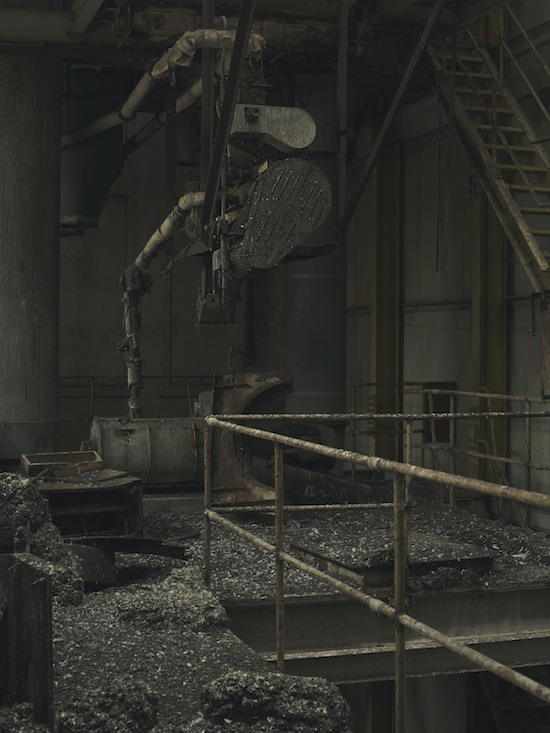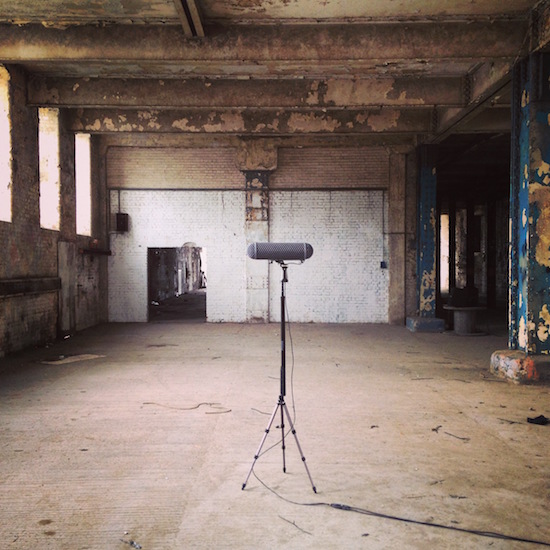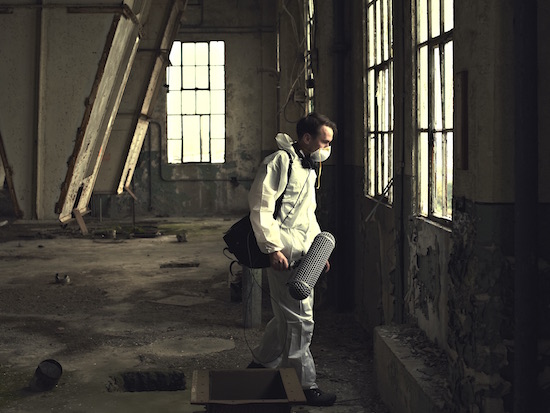All photographs courtesy of Daniel Benson
"There’s a sense of space in the Docklands that I quite like. It makes interesting sounds when things are so separated and disparate. There’s a different sonic quality to inner-city London."
I’m walking around the site of the Millennium Mills with sound artist and composer Aino Tytti. He recently spent four months here, coming in each weekend to wander around the vast art deco tower of the Spillers building and the peculiar functionalist edifice known as D silo, to record sounds for a forthcoming release on Touch Music.
But today, as we pause outside one of the big steel gates that have come up around the site, a man in a hi-vis jacket pointedly walks up to slam the gates in our face.
Do you think that was for our benefit? I ask.
"I don’t know. If you look on the internet, there’s a lot of ‘urban explorers’ that have come here, wanting to take a look round."
We pause in front of a sign bearing an artist’s impression of the building’s future, gleaming in a ray of light that looks straight out of some Renaissance vision of God’s benediction, while a cheerful sans serif promises a "new home for leading edge business, brands, culture, learning and living".
"Doesn’t it look pretty?" says Aino Tytti. "We’ll see…"
Aino Tytti is not his real name. It comes from the Finnish epic poem, The Kalevala. Literally translated, it means "the only daughter". "Aino’s tale in the story is quite a tragic, melancholic one," he explains, "but there’s an element of hope there, and I’m really drawn to those two combined notions. The points of correspondence between hope and melancholia have always been a rich source of inspiration for my work, so I guess that’s why I took her name."
"When I’m composing or trying to find inspiration, I have to shut down a lot of my everyday thought processes," he continues, "so I can focus and listen and work in the way I need to. Abstractly speaking, Aino is someone that sits within me and it’s her that performs the composition work – so much so that sometimes I’ll spend all night working on a piece and then come back to it a few days later and, in the light of day, not even recognise the piece that has been created."
Aino Tytti is a self-taught composer, finding his way to a unique and rather moving compositional voice outside the strictures of the academy or the bustle of any particular scene. In a sense, you could say that he was taught by the source materials he works with, building up vast orchestras of sound through field recordings then whittling them down through long, patient hours of listening. As a result, the vocabulary he uses to talk about his music can tend less towards crotchets and sforzandos, more touch and texture.
"Quite often," he says, "I’ll internally describe the sound I am creating by way of what the various layered textures feel like to the touch." It’s a process he likens to sculpture, "visualising and forming a physical object, which is then flattened and rendered into sound at the end".
This is not his first piece for Touch. A couple of years ago, he attached an array of contact microphones to a long-range radio transmitter on the edge of a glacier in Iceland, on the Snæfellsnes peninsular. "It’s the tallest structure in western Europe, which drew me to it," he says, "but I’ll admit to an element of luck, being in the right place at the right time to capture the recordings that I did." The results are truly magical – especially when the spectral drones and keening susurrus are broken through, for just a moment, by a haunting violin solo, broadcast from who knows where.
The present project at the Millennium Mills germinated a little over a year and a half ago when Aino Tytti wrote to the Greater London Authority asking if he could do some recording in the long abandoned complex. "I expected them just to say, no, sorry, there’s no chance," he tells me. "But they were quite welcoming to the idea." They got talking, showed him round, and after a bit of persuasion, eventually left him there to his own devices. "I got a good rapport going with the nightwatchman."
Aino Tytti had first spied the place around the time he moved to London, from Sheffield, ten years ago. The plan had been to stop off in the city just briefly before heading on to Berlin. Somehow London got its claws in and he’s been here ever since. Before long he’d started filling his days taking random journeys on the Docklands Light Railway. It was probably inevitable that the Millennium Mills would catch his eye, looming out of the new developments and abandoned warehouses of Silvertown like some bizarre totem of a long lost age. In a recent article for The Guardian, Owen Hatherley called it "the last untouched ruin" in the capital. Not for long.

The area is transforming, both above ground and beneath. Placing hydrophones in the wharf, Aino Tytti was able to hear the deep sub-bass of Crossrail being tunnelled out below, "which reverberates around the basin, through the water. It sounds quite otherworldly." His soundwork, then, has become more than just a piece of music: also a document of deep-level transformations to the capital’s structure dating back over a hundred years and still ongoing to this day.
From the outside, the Millennium Mills still look much as they did when Aino Tytti first saw the place. The asbestos has been cleared out – he had to wear a hazmat suit while recording – and just one side of the Spillers building has been cleaned (the side facing across the wharf towards the ExCeL centre, naturally), so it now looks as white as it did when Jean-Michel Jarre first painted it for his laser-happy Destination Docklands project in 1988. But otherwise it is still recognisably the post-apocalyptic location for Terry Gilliam’s Brazil, Stanley Kubrick’s Full Metal Jacket and Derek Jarman’s The Last of England, a "hulking symbol", as Hatherley put it, "of London’s decline".
Soon it will resound with the pinging of a thousand iPhones, brand pavilions will sing with digitally recorded ukuleles, all the cosily reassuring sounds of 21st-century capital. No one will ever again be able to capture the scurry of mice through inch-thick pigeon shit reverberating through 63 acres of highly reflective concrete. Prince Charles himself demanded that the old red brick chimney be preserved for posterity so they turned it into a roundabout, isolated and inaccessible, half surrounded by cottage-y little houses from the last round of major redevelopment. But who cries for the loss of a soundmark?
"You don’t get buildings like that anymore," Aino Tytti says. We’re standing before the impassive face of D silo. "When you’re walking around it, you’re struck by the notion that it’s a building that’s been created based on a specific way of doing things and then the building is made around the top of it. The way to do it these days is to take an empty shell and fit your process in the best way you can." He would set up PA systems inside and blast out sine tones and sung harmonies, then record the way they interacted with the space, trying to "use the environment as an instrument." His processes, inevitably, would extend from the space itself.

"As is the way with these things, I spent a lot of time installing these big PA rigs in there, and I think I got most of the best work just from rigging up two megaphones, with this really scratchy, tinny quality. In such an expansive space – even setting them up on the bottom floor – if it’s really quiet, you can just about hear them through the various different holes in the floor and the silos."
In his quest to eke out all the site’s sonic mysteries, Aino Tytti took to spending the night there. "It’s not a very hospitable environment," he admits. "I don’t think I got much sleep. You’re convinced that the noises are louder and that the environment is more alive at night. But the recordings don’t lie to you. You come back after what you thought was an incredibly noisy night, full of interesting noises, but then you realise you got better stuff during the day. That’s part of it, in a way. Putting yourself in that situation."
He confesses to me that he did start to get "a bit obsessed" with the place, quickly adding "which you need to do". He even thought about moving to the area. "I tried to talk the missus into it."
She wasn’t having it?
"No. But there’s just something about it that I quite like. Even the fact that it’s got this massive exhibition centre across the way. It adds a sense of temporariness to it. Everything feels like it’s quite temporary. But obviously it’s one of the oldest buildings in London."
Aino Tytti plays the Fiddler’s Elbow in Kentish Town, London, tonight; for full details and tickets, head here. His new album, based on processed recordings at the Millennium Mills, will be released on Touch shortly after


